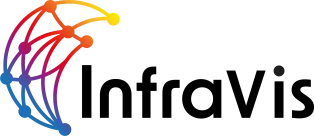InfraVis@LU
InfraVis is a Swedish national Research Infrastructure for data visualization. InfraVis helps you visualize research data from any scientific domain and gives you access to state-of-the-art visualization competence, support, equipment, training, and methods. InfraVis@LU is the InfraVis node for Visualisation and Analysis at Lund University, coordinated by CIPA.
InfraVis provides advanced visualization support, equipment, training and methods in order to help researchers all over Sweden optimize their workflow, detect trends in their research data and make discoveries that they might miss without employing data visualization as a research tool. InfraVis unites visualization experts from nine partner universities, including Lund University, and is financed by the Swedish Research Council and co-financed by the nine partner universities.
In this initial phase, InfraVis provides visualization support to researchers affiliated with the partner universities. However, considering that the research infrastructure aims at creating competitive advantages for researchers around Sweden, InfraVis will continually expand and provide data visualization services to researchers at other Swedish universities and institutions as well.
You will find more information about InfraVis on infravis.se
InfraVis@LU – Visualisation and Analysis at Lund University
The InfraVis@LU team serves researchers in need of visualisation support in all fields of science – from the nano world to the size of the universe. The team includes experts in virtual reality, microscopy, tomography and machine learning, AI, spectroscopy, data processing and analysis and eye-tracking. One of the national technical managers of InfraVis – Kajsa M Paulsson – is based at the LU node. Emanuel Larsson is the LU node coordinator for InfraVis.
Below is a list of research infrastructures at Lund University that are actively contributing to data visualization support within InfraVis.
CIPA
CIPA (Correlative Image Processing and Analysis; cipa.lu.se) is the coordinating unit for InfraVis@LU. CIPA provides access to image analysis expertise, tools for handling high-end data and analysis as well as training for users. CIPA also contributes to linking infrastructures for imaging, data handling and analysis distributed at both Lund University and other organisations. The CIPA team at Lund University has a strong cross-disciplinary composition with members from the Faculties of Medicine, Science and Engineering.
LU Humanities Lab
LU Humanities Lab (www.humlab.lu.se) is an infrastructure for the study of human behaviour in a broad sense (abbreviated as cognition, communication, and culture) at Lund University. It offers LU researchers free access to advanced sensor-based technology generating 2D and 3D data (e.g. EEG, eye-tracking, motion capture, laser scanning, electromagnetic articulography), the e-scientific/AI tools including language technology to work on the data, methodological know-how, and training.
Virtual Reality Lab
The Virtual Reality Lab (www.design.lth.se/english/the-department/research-laboratories/virtualr…) at Lund university is an infrastructure for research and innovation utilizing virtual reality (VR) and augmented reality (AR) technology for a wide range of applications. It offers a broad spectrum of hardware, from large immersive VR systems to wearable AR and various types of interaction e.g. eye tracking and haptics.
AI Lund
AI Lund (www.ai.lu.se) is an interdisciplinary network for research, education and innovation in the field of Artificial Intelligence. It is coordinated by Lund University and open to members from academia, industry, public sector and other organisations. The network has been formed to consolidate these activities and simplify contacts with students, industry and society as a whole. Members of AI Lund make active contributions to the analysis of data, e.g. by using deep neural networks to classify medical images.
LUNARC
LUNARC (www.lunarc.lu.se) is the centre for scientific and technical computing at Lund University as well as long-time member of the Swedish National Infrastructure for Computing (SNIC). LUNARC has operated several high-performance computing, storage, and visualisation resources for both LU and SNIC. LUNARC provides training and has worked in development projects including LU Humanities Lab and LBIC. Application experts within LUNARC are integrated directly into both CIPA and QIM.
QIM
The Center for Quantification of Imaging Data from MAX IV (www.lunarc.lu.se/projects/qim) develops algorithms for quantitative image analysis. The aim of QIM is to support research carried out a large-scale imaging facilities, including both industrial and clinical applications. QIM is experienced in analyzing samples across a wide range of scientific disciplines. Projects are carried out either in close collaboration with experimental scientists or on a consultancy basis. Developed tools are made freely available.
LBIC
The Lund University Bioimaging Centre (LBIC; www.lbic.lu.se) is the imaging core facility at the Faculty of Medicine, Lund University. LBIC hosts platforms for data collection and has further some resources for image analysis.


